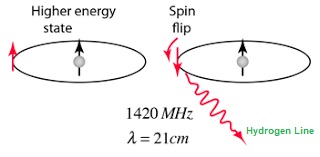From UPSC perspective, the following things are important :
Prelims level: Hydrogen Line and its significance in interstellar studies

Why in the News?
The hydrogen line stands as a pivotal tool in contemporary astronomy, serving various purposes from studying distant stars to questing for extraterrestrial intelligence, should it exist.
What is a Hydrogen Line?
|
Why is it Important?
- Hydrogen is everywhere in the universe. It’s the simplest and most abundant element, making up about 75% of the universe’s elemental mass.
- So, studying the hydrogen line allows us to understand a lot about the composition and distribution of matter in the universe.
- By observing the hydrogen line’s emission from different regions of space, astronomers can create maps showing where hydrogen gas is located.
- Secrets about the early Universe: The hydrogen line also holds secrets about the early universe. Shortly after the Big Bang, the universe was filled with hydrogen gas.
- By studying the hydrogen line from distant parts of the universe, astronomers can learn about its conditions and evolution billions of years ago.
How Do We Interpret Hydrogen Line?
|
What’s Next?
- New Discoveries: Scientists are continually developing new technologies and techniques to improve the sensitivity and resolution of radio telescopes.
- This enables them to detect fainter signals and uncover new insights into the universe’s hydrogen content.
- Exploring Dark Matter: The hydrogen line observations could also contribute to understanding dark matter, an invisible substance that makes up about 27% of the universe’s total mass-energy content.
- By studying the hydrogen distribution in relation to the gravitational effects observed in galaxies, scientists hope to shed light on the nature of dark matter.
PYQ:[2012] A team of scientists at Brookhaven National Laboratory including those from India created the heaviest anti-matter (anti-helium nucleus). What is/are the implication/implications of the creation of anti-matter?
Select the correct answer using the codes given below: (a) 1 only (b) 2 and 3 only (c) 3 only (d) 1, 2 and 3 |
Get an IAS/IPS ranker as your 1: 1 personal mentor for UPSC 2024
